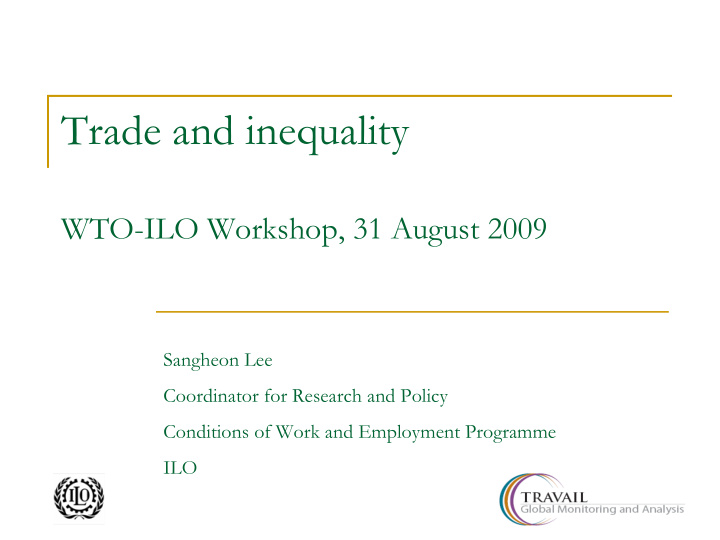



Trade and inequality WTO-ILO Workshop, 31 August 2009 Sangheon Lee Coordinator for Research and Policy Conditions of Work and Employment Programme ILO
Three issues Why inequality? What inequality? Wage/income differentials Functional income distribution What determines inequality? “Political economy” of trade and inequality?
Why inequality? Policy implications and perspectives Inequality as an independent or dependent variable? “Good” and “bad” inequalities – tautological? “[T]he rising returns to schooling and increasing dispersion of wages represent “good” inequalities because they reflect freer labor markets with increased incentives for work and for skill acquisition. But, naturally, those with relatively little schooling and few assets or little access to credit are less able to respond to these incentives and less well positioned take advantage of the new opportunities unleashed by market-oriented reforms. Thus, inequalities in opportunities to accumulate human capital are “bad” inequalities in that they have retarded poverty reduction through growth…” (Chaudhuri and Ravallion 2007, p. 177)
What inequality? Wage/income differentials Usual focus on skill premium Indicators: Deciles ratios, Gini coefficients etc What about functional income distribution? For instance, wage/income share Potentially more important role by the “financialization” of the global economy?
Ex 1. Trade and wage inequality Source: ILO Global Wage Report 2008/9
Ex II. Trade and wage share Source: ILO Global Wage Report 2008/9
Kuznetian turning point? Both theory and evidence does not provide any strong reason Figure 1 . Adjusted Gini coefficients and GDP (OECD countries) Source: Francois and Rojas-Romagosa (2008), Figure 6.1.
Kuznetsian perspective (I) Combined dynamics of individual and functional income distributions Framework Three income groups High income group in the urban sector Low income group in the urban sector (with migrant flow from the rural sector) Low income group in the rural sector Two forces towards widening inequality “Concentration of savings in the upper-income brackets” “Industrialization and urbanization” Counteracting factors “Legislative interference and “political” decisions”, reflecting a “re- evaluation of the need for income inequalities as a source of savings for economic growth” (p.9) This “political” process took place, due to “the growing political power of the urban lower-income groups” (p. 17)
Kuznetsian perspective (II) Cautions against … A long swing in inequality should not be taken granted. It may not take place due to “the failure of the political and social systems of underdeveloped countries to initiate the governmental or political practices that effectively bolster the weak positions of the lower-income classes” ( ibid . p.24) The need to maintain high inequality for economic growth may be specific to the old “industrialized countries” and not applicable to the developing world. He was particularly critical of the argument that “because an unequal income distribution in Western Europe in the past led to accumulation off savings and financing of basic capital formation, the preservation or accentuation of present income inequalities in the underdeveloped countries is necessary to secure the same result” ( ibid, pp. 25-26) The role of trade (policies) in this political process? Given the preliminary empirical evidence about the relationship between trade and wage share labour market institutions bargaining power
Kuznetsian perspective (II) Towards “political and social economy” “If we are to deal adequately with processes of economic growth, processes of long-term change in which the technological, demographic, and social frameworks are also changing – and in ways that decidedly affect the operation of economic forces proper – it is inevitable that we venture into fields beyond those recognized in recent decades as the province of economics proper. For the study of the economic growth of nations, it is imperative that we become more familiar with findings in those related social disciplines that can help us understand population growth patterns, the nature and forces in technological change, the factors that determine the characteristics and trends in political institutions, and generally patterns of behaviour of human beings – partly as a biological specifies, partly social animals. Effective work this field necessarily calls for a shift from market economics to political and social economy .” (p. 28; emphasis added)
Recommend
More recommend